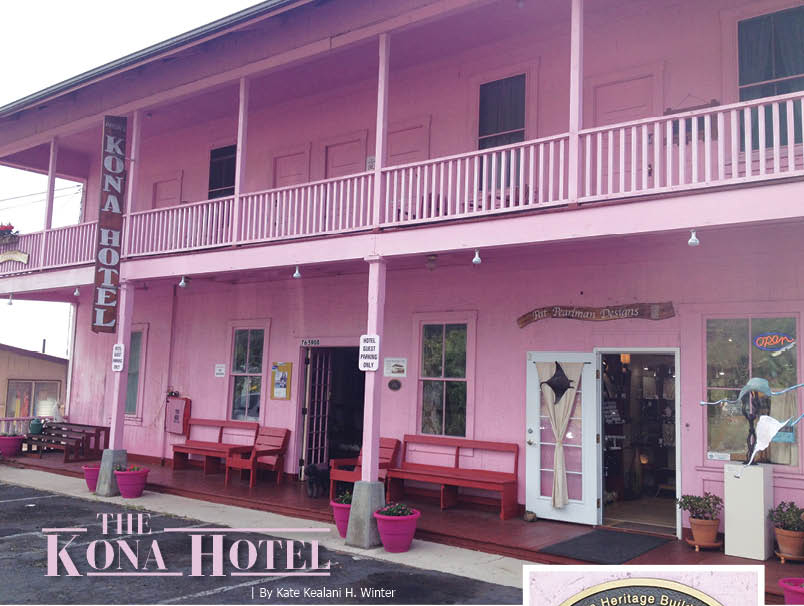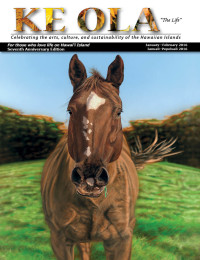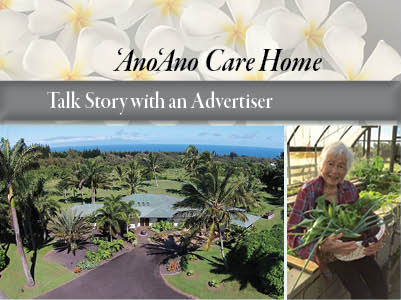
The Kona Hotel
 It’s hard to miss the Inaba’s Kona Hotel, which sits on the side of old Māmalahoa Highway in Hōlualoa. With its bubblegum pink exterior and double lānai stretching across the front, it invites passersby to sit and rest awhile. The Douglas fir 1-by-12s and corrugated metal roofs have withstood the afternoon clouds, rain and bright morning sun that Hōlualoa is known for. Like every historic building, the hotel is a mingling of past and present. By the front door hangs an oval plaque identifying the hotel as a “Kona Heritage Building,” designated as such by Pulama Ia Kona, the Heritage Preservation Council.
It’s hard to miss the Inaba’s Kona Hotel, which sits on the side of old Māmalahoa Highway in Hōlualoa. With its bubblegum pink exterior and double lānai stretching across the front, it invites passersby to sit and rest awhile. The Douglas fir 1-by-12s and corrugated metal roofs have withstood the afternoon clouds, rain and bright morning sun that Hōlualoa is known for. Like every historic building, the hotel is a mingling of past and present. By the front door hangs an oval plaque identifying the hotel as a “Kona Heritage Building,” designated as such by Pulama Ia Kona, the Heritage Preservation Council.

The pink hotel—and yes, the family says it has always been some shade of pink—was built in 1926 by Jindero and Hatsuyo Inaba. Both had come to Hawai‘i just before 1900 to work on the sugar plantations on the Hāmākua side of the island. Many other Japanese like them moved to the Kona side of Hawai‘i Island to escape the hardships and discrimination of plantation life. Jindero himself walked from Pepe‘ekeo on the east side all the way to Kona where he and many others found independence and opportunity.
He planted some of the first coffee in the ahupua‘a of Wai‘aha (an ancient land division), making him one of the Kona coffee pioneers. He also worked for decades as a cook for a German immigrant family in Hōlualoa. After 27 years in Hōlualoa, he and his wife, Hatsuyo, opened the Kona Hotel in 1926.
The three-story hotel still perches along the old road that has been designated an American Scenic Byway. Ten miles of curving, two-lane road that is now Route 180, runs from Palani Junction on the north to Honalo Junction on the south. Once a part of a footpath that encircled the entire island, this section ran along the shoulder of Hualālai Volcano at 1400 feet above sea level. Changing from path to trail and then to road, it became the main access road for the community in Hōlualoa mauka (up the mountain as opposed to makai or toward the ocean).
It connected the elements of the ancient Kona Field System, an agricultural swathe of the uplands that was meticulously cultivated to feed the inhabitants of the Kona district. As the road wound through the area, it passed small general stores, a few gas stations, an occasional saloon, and places of worship and burial.
Eventually Hōlualoa became a “sugar town,” the only one in the Kona district, and by 1926 coffee orchards had been converted to sugar plantation lands. Commercial sugarcane kept the economy going for 27 years while Hōlualoa grew into the commercial hub. Tourists and traveling salesman going around the island by car needed a comfortable place to rest because no one could make the trip in one day. The Inabas spotted an opportunity and built the hotel. Jindero cooked and served three full meals a day and provided a taxi service. In those days, Hōlualoa had everything anyone needed: stables for horses and mules, a theater, a store, churches, a saloon, a gas station, a doctor and a hotel.
Then in the early 1950s, Kuakini Highway was built from Honalo Junction down to Kailua Village, and traffic through Hōlualoa declined.
These days, the Inaba family gathers on occasion for a potluck supper and Ke Ola was recently invited to attend. A parade of family members came through the wide front doors of the hotel, along the hallway that runs through the center of the building all the way to the back. Soon, a buffet table was neatly spread with family favorites, and Mrs. Yayoko Inaba, the second generation of the Inaba family to run the 89 year old hotel, took her place at the table.
The dining room, with family portraits and lace curtains, has a traditional butsudan in one corner. On a shelf over the butsudan, a folded American flag is a remembrance of Goro Inaba, second generation hotelier and Yayoko’s husband. In busier days, tables were artfully arranged with wood-framed fabric screens between them, giving each table some measure of privacy. The cloth was printed in the traditional blue and white announcing that one was a guest at the Kona Hotel. A single one of these screens remains today in a doorway between the lobby lounge area and the dining room.
An old Singer sewing machine sits in the lobby of the hotel. The family reminisced that Goro remembered his mother, Hatsuyo, as being tough and strong, working right along with her husband to run the hotel, raise eight children, serve as a midwife, and manage a business sewing lauhala slippers and men’s trousers plus giving sewing lessons.
Goro himself went away to school but returned to Hōlualoa and the family hotel business afterwards. They also recounted what Goro recalled about the restrictions that World War II brought to the Japanese-American community, including the internments. However, the Inaba family was allowed to keep their hotel open for business, although as “enemy aliens,” they were required to make detailed weekly reports to a local official.
In 1943, Goro enlisted in the US Army and served in Europe with the famous 442nd Regiment.
At 22, Yayoko was working for the Territorial government in Kona, staying at a place that did not have the luxury of baths. One of the Inaba boys invited her to come to the hotel to bathe; she met Goro and soon after they married. After his military service, the couple helped the elder Inabas with running the hotel and doing the cooking.
Now the scenic road winds past historic buildings, coffee farms, art and artisan galleries, lava outcroppings, and old dry stack rock walls. The trip still offers spectacular views of the mountainside and shoreline of the Kona coast.
These days, the hotel lobby has comfortable vintage Hawaiian furniture to relax on, and in one corner there is a hospitality station where coffee and snacks are offered. A breeze wafts through the open hallway that runs through the heart of the building’s second and third floors. Two staircases—one in the front part of the lobby near the front desk and the other in the back by the kitchen and family quarters—lead to 11 third floor rooms. Hawaiian music drifts on the breeze through the lobby.
Out back, an open-air walkway leads past the family quarters to the lua (bathroom) at the far end where the views of the coastline and sunsets are another reward. Upstairs there are two modern bathrooms—one for men, one for women—adjacent to the guest rooms. The windows of every room frame the beautiful views. The air conditioning is entirely natural so daytime ocean breezes and nighttime mountain winds cool the immaculate accommodations.
Goro Inaba was remembered as saying he never advertised the hotel, and apparently he didn’t need to.
What makes this pink hotel such an appealing place to pause and rest?
The quiet, of course. And the sense of place. Over a door from the lobby into the dining room hangs a gyotaku painting of a marlin caught by a family fisherman. This is Kona, the bill fishing capital of the world.
The hotel is itself an unpretentious celebration of endurance and aloha. Everything about the Kona Hotel feels authentic, not manufactured for the tourist trade. Near the front desk in the lobby rests the old cash register on display. The long front lānai is well equipped with chairs to watch and listen as life in Hōlualoa goes by. It was there that I met a Swiss tourist one evening while he savored a local brew along with the night air. He told me that he stayed two nights at the pink hotel, then went on to see other parts of the island, and quickly returned to stay again at the Kona Hotel because that was the best place to be. ❖
Contact Kona Hotel: 808.324.1155
Contact writer and photographer Kate Kealani H. Winter


